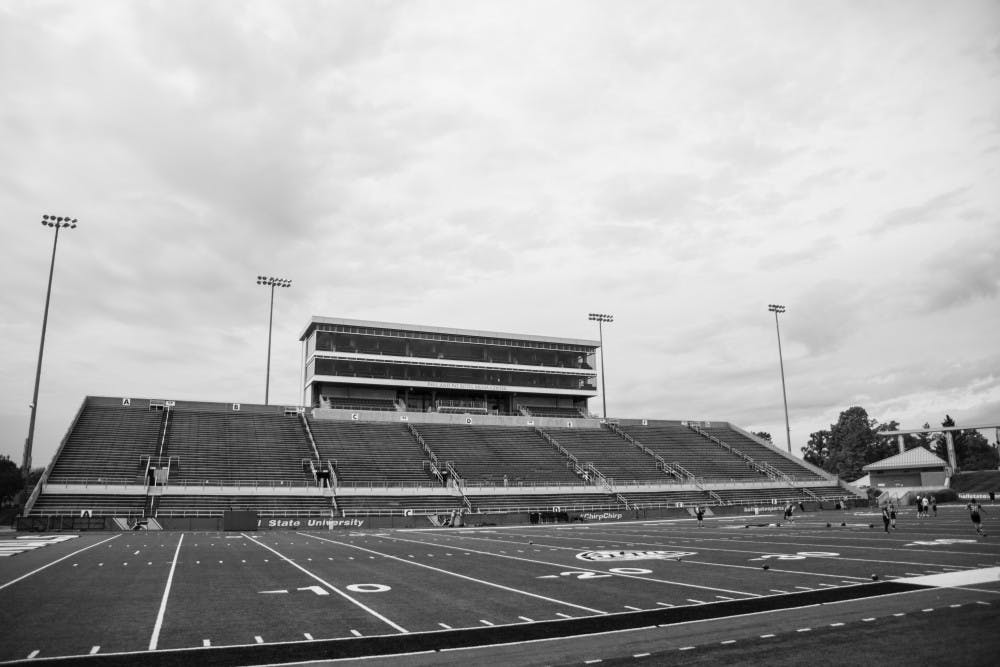Average attendance at MAC football games in 2015
1. Ohio, 21,323
2. Toledo, 20,842
3. Bowling Green, 19,608
4. Western Michigan, 19,441
5. Buffalo, 18,457
6. Akron, 18,098
7. Miami (Ohio), 15,707
8. Central Michigan, 15,672
9. Northern Illinois, 13,942
10. Kent State, 12,561
11. Ball State, 7,974
12. Eastern Michigan, 4,897
Media reports from Mid-American Conference schools Eastern Michigan University and Kent State University show that universities are experimenting with a new marketing strategy: selling beer at stadiums.
Will Ball State see beer at Scheumann Stadium anytime soon? Shawn Sullivan, Ball State’s assistant athletic director for marketing and fan engagement, says there have been discussions but nothing anywhere close to final decisions.
“I think it’s always a discussion point, and we’ve certainly had internal discussions about it,” Sullivan said. “But there are several discussion points that may increase revenue and attendance and that’s just one of many options that we talk about.”
While there are no plans to sell alcohol in the immediate future, one thing is clear — attendance at Cardinals football games was one of the lowest in the country in 2015.
Home field advantage?
The Battle for the Bronze Stalk between Ball State and Northern Illinois might not be one of the most well-known matchups in college football, but rivalry games usually bring in a decent amount of spectators.
However, it’s not likely that anyone is considering a crowd of 7,249 a decent amount given Scheumann Stadium’s capacity of 22,500 people.
Low attendance figures aren’t out of the ordinary for Ball State. In 2015, the Cardinals were second-to-last in the Football Bowl Subdivision, the NCAA’s highest classification, with an average attendance of 7,974.
To put that number in perspective, 45 teams in the Football Championship Series, one rung below FBS programs, and four Division II schools had higher averages than Ball State. Even Quebec's Université Laval, a Canadian Interuniversity Sport member, had more fans in the stands (13,109 fans per game).
It’s also more than 7,000 short of the NCAA’s average attendance goal.
NCAA by-law 20.9.7.3 states, “once every two years, the institution shall average at least 15,000 in paid or actual attendance for all home football games.” If schools don’t meet that threshold, they’re required to go under a certified audit of attendance figures.
“We have to play by the rules that every other school plays by,” Sullivan said.
Filling the stands
Sullivan says Ball State is trying to increase attendance by using student reward programs, freshman orientation and the student section, “The Nest."
“We try to use some of our on-campus partners to try and notify students that we’ve got fun entertainment right here on campus,” Sullivan said. “We’d like them to join us whenever possible.”
So far this year, four MAC schools have seen a higher single-game attendance number than they did last season. Eugene Canal, director of athletics communications at Kent State, said his school's marketing strategies — particularly the "Golden Flashes Run," where students were allowed to run onto the field before the home opener — have worked.
Along with the "Golden Flashes Run" and beer sales, Kent State and its student government sponsor student tailgates that feature a large pizza for every spot reserved, games and a DJ.
Of course, those are all off-the-field solutions. There's another tried and true method to fill the stands. To quote the late Al Davis, former owner of the NFL's Oakland Raiders:
"Just win, baby"
In 2008, Ball State finished the regular season with a 12-0 record, earning a spot in the Associated Press Top 25 poll. The Cardinals finished that season with an average attendance of 19,200 and, in their 12th game, set the Scheumann Stadium record with 23,861 in attendance against Western Michigan.
In 2015, the top four average attendance figures in the MAC were from schools that finished the season with winning records. The bottom four averages were from teams with losing records, including a 3-9 Ball State team.
“Certainly the product on the field hasn’t been great the last couple of years, and I think that plays a factor,” Sullivan said. “We also haven’t had the best weather the past couple of years, but those are no excuses. We can’t use them as crutches.”
Five of the 10 lowest average attendances last season were from MAC schools, partly because the averages are skewed by poorly-attended mid-week games. Ball State has two Tuesday night home games on its schedule this year.
“Those games haven proven to be difficult,” Sullivan said. “Those games aren’t friendly for families and they typically haven’t been friendly from a weather standpoint.”
But mid-week MAC games are also broadcast nationally, which Sullivan says brings exposure — both with fans and recruits — and makes them worth playing.
After all, Saturday games are usually buried online while fans at home tune in to see big-name programs, like Notre Dame.
James Johnson, associate professor and graduate coordinator for sport administration at Ball State University, said mid-major schools such as Ball State just don’t have the stature compared to other FBS institutions that have a national footprint and sell out stadiums.
“Notre Dame, for example, will likely sell out every game this year no matter the circumstance,” Johnson said. “Ball State doesn’t have that luxury.”
And when it comes to alcohol sales, Johnson is skeptical of its long-term success.
“It may show a small spike in attendance initially due to the novelty,” Johnson said. “But I doubt it would be the deciding factor for most people to attend a game.”
But alcohol sales are probably a few years down the road, if they ever come at all. For now, Ball State is just trying to fill seats for Saturday's 3 p.m. Homecoming game against Akron.





